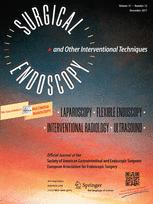Bell RC, Kurian AA, Freeman KD
Surg Endosc. 2015 Jul;29(7):1746-52.
BACKGROUND:
Transoral incisionless fundoplication (TIF) treats gastroesophageal reflux disease (GERD) by creating a full-thickness esophagogastric plication using transmural fasteners. If unsuccessful, revision laparoscopic anti-reflux surgery (rLARS) may be performed. This study evaluated operative findings and clinical outcomes of rLARS in 28 patients with prior primary TIF.
METHODS:
Intraoperative findings, complications, and symptomatic outcomes with GERD health-related quality of life (GERD-HRQL) were evaluated prospectively in patients having rLARS after TIF. Results are median with interquartile range (IQR).
RESULTS:
Between 03/2009 and 08/2013, 28 patients underwent rLARS at 14 (13-50) months post-TIF for recurrent symptoms after initial improvement. Pre-rLARS endoscopies found hiatal hernia (9) and wrap disruption (12). All revisions were completed laparoscopically in 88 (70-90) min. Eight patients underwent partial fundoplication, the rest Nissen. No intraoperative or postoperative complications occurred. Operativefindings included: No axial hernia in 65 %; Dense adhesions in 14 %; Fasteners incorporating the lateral crus in 95 %; Traction diverticuli from esophagus to crura in 21 %. Residual plication was noted anteriorly in 75 %, posteriorly in 0 %. Operative approaches: (1) Areas where the TIFfundoplication remained were left intact. This necessitated rolling the fundoplication over the fused area to prevent an endoscopic appearance of ‘fold’. (2) Fasteners were cut and left to migrate into the lumen, rather than being pulled out. (3) In 8 patients with fusion of the lateral crus to TIFfundoplication and no axial hernia, revision fundoplication was performed without mediastinal mobilization but with posterior hernia repair. One patient required subsequent surgery for small paraesophageal hernia, one for refractory gas-bloat after rLARS. Dysphagia in 2 patients resolved with dilation. GERD-HRQL improved from a median of 20 (8-27) pre-TIF and 10 (1-20) pre-rLARS to 3 (0-4) at 28 months (12-40) post-rLARS (p = 0.020 for pre-rLARS to post-rLARS).
CONCLUSION:
rLARS after TIF can be performed safely with excellent clinical outcomes.
Link to abstract on PubMed: Bell RC, et al; Surg Endosc. 2015 Jul;29(7):1746-52.


